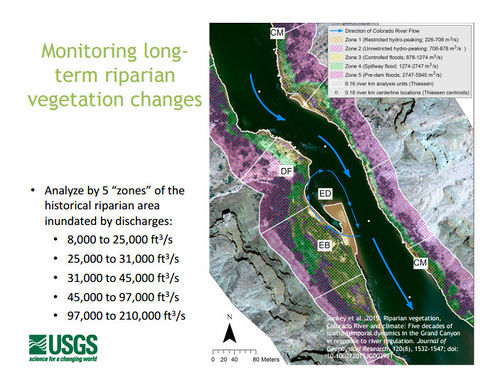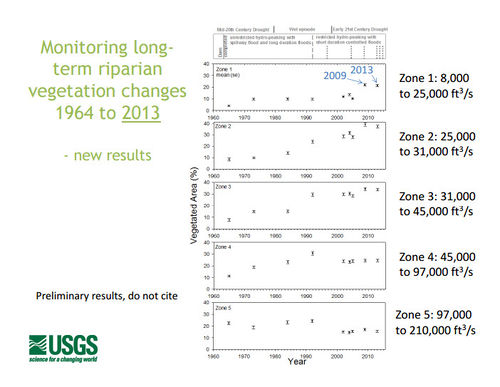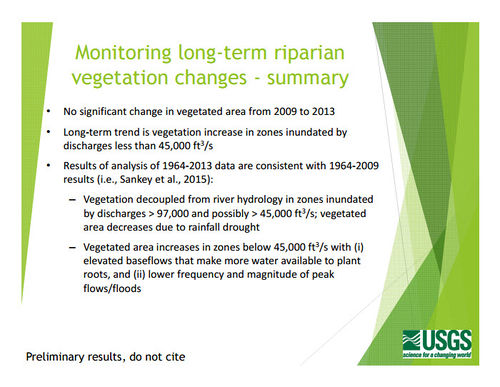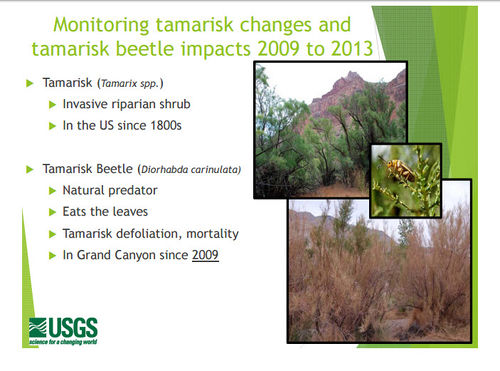Difference between revisions of "Riparian Vegetation"
Cellsworth (Talk | contribs) (Created page with " __NOTOC__ __NOEDITSECTION__ <!-- ------------------------------Banner across top of page------------------------------> {| style="width:100%; background:#fcfcfc; margin-to...") |
Cellsworth (Talk | contribs) |
||
| Line 44: | Line 44: | ||
• Habitat for neotropical migratory birds, waterfowl, and other appropriate native bird species.<br> | • Habitat for neotropical migratory birds, waterfowl, and other appropriate native bird species.<br> | ||
• Ecological functions of tributary mouths and riverside springs, including habitat for native species.<br> | • Ecological functions of tributary mouths and riverside springs, including habitat for native species.<br> | ||
| + | |||
| + | == LTEMP Experimental Action: Native and Nonnative Plant Management and Experimental Treatments (BA, pages 41-42) [https://www.fws.gov/southwest/es/arizona/Documents/Biol_Opin/120059_LTEMP%20BiOp_11-25-16.pdf]== | ||
| + | |||
| + | '''Experimental riparian vegetation treatment activities''' would be implemented by NPS | ||
| + | under the proposed action and would modify the cover and distribution of riparian plant | ||
| + | communities along the Colorado River. All activities would be consistent with NPS | ||
| + | Management Policies (NPS 2006) and would occur only within the Colorado River | ||
| + | Ecosystem in areas that are influenced by dam operations. NPS would work with tribal | ||
| + | partners and GCMRC to experimentally implement and evaluate a number of vegetation | ||
| + | control and native replanting activities on the riparian vegetation within the Colorado | ||
| + | River Ecosystem in GCNP and GCNRA. These activities would include ongoing | ||
| + | monitoring and removal of selected nonnative plant species, systematic removal of | ||
| + | nonnative vegetation at targeted sites, and native replanting at targeted sites, which may | ||
| + | include complete removal of tamarisk (both live and dead) and re-vegetation with native | ||
| + | plants. Treatments would include the control of nonnative plant species and revegetation | ||
| + | with native plant species. | ||
|}<!-- | |}<!-- | ||
Revision as of 13:21, 1 March 2017
|
|
Riparian VegetationMaintain native vegetation and wildlife habitat, in various stages of maturity, such that they are diverse, healthy, productive, self-sustaining, and ecologically appropriate. Desired Future Condition for Native Species and Biotic CommunitiesNonfish Biotic Communities: CRE Riparian Domain: LTEMP Experimental Action: Native and Nonnative Plant Management and Experimental Treatments (BA, pages 41-42) [1]Experimental riparian vegetation treatment activities would be implemented by NPS under the proposed action and would modify the cover and distribution of riparian plant communities along the Colorado River. All activities would be consistent with NPS Management Policies (NPS 2006) and would occur only within the Colorado River Ecosystem in areas that are influenced by dam operations. NPS would work with tribal partners and GCMRC to experimentally implement and evaluate a number of vegetation control and native replanting activities on the riparian vegetation within the Colorado River Ecosystem in GCNP and GCNRA. These activities would include ongoing monitoring and removal of selected nonnative plant species, systematic removal of nonnative vegetation at targeted sites, and native replanting at targeted sites, which may include complete removal of tamarisk (both live and dead) and re-vegetation with native plants. Treatments would include the control of nonnative plant species and revegetation with native plant species. |
| --- |
--- |
--- |
|---|



